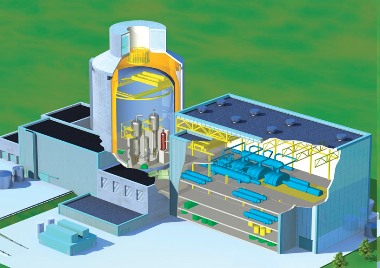Nuclear reactor gets OK on aircraft impact
24 January 2011
American regulators are happy that the impact of a large aircraft on a Westinghouse AP1000 nuclear power plant would not jeopardise nuclear safety.
Essential safety functions at a nuclear power plant are to protect the highly radioactive nuclear fuel in the reactor core and maintain a cooling flow of water to avoid it overheating. The same goes for the fuel once it has been used and transferred to storage ponds within the reactor building.
Critical to these are the structural strength of the reactor building - especially the concrete containment structures and the airtight metal containment vessel within. Several layers of powered and passive safety systems also need to be absolutely reliable when required, unaffected by the impact or subsequent fire. This must be the case even with reduced operator involvement such as could be expected during such an emergency.
 |
| AP1000's building structure and containment vessel (coloured blue) |
Although a 11 September-style attack on a nuclear power plant is described as 'beyond design basis', rules brought in after that event by the Nuclear Regulatory Commission (NRC) require reactor vendors to describe design features that meet the above requirements.
The AP1000 received design certification in 2005, before the NRC brought in the rule on aircraft impact. The company thus redesigned the AP1000 shield building and submitted their justification of the design. One effect of strengthened buildings was to reduce passive heat removal airflow, NRC noted, but this effect was acceptable while affording greater protection from external impact.
The eventual conclusion of the NRC's Advisory Committee on Reactor Safeguards (ACRS) on 19 January was: "Analyses show that the containment remains intact following the impact of a large commercial aircraft. The reactor core remains cooled, and spent fuel integrity is maintained." The AP1000 presents "a small target with a reduced set of safety-related structures, systems and components." The ACRS noted that passive systems provide core cooling, no active equipment is required for fuel pond cooling and at least one backup water source is always available.
Separately from penetration and fire, the 'shock loadings' on the power plant buildings from aircraft impact were shown to be less than potential earthquakes already accounted for during normal design analysis.
One feature of the AP1000 containment is an opening in the roof for passive heat removal, surrounded by a water storage tank. A concern had been the potential for "significant aircraft impact debris" to pass through the gap and hit the steel containment vessel. The ACRS actually concluded that "no significant debris would impact the containment vessel" but a conservative analysis by Westinghouse showed that the vessel could be dented but not penetrated.
Researched and written
by World Nuclear News